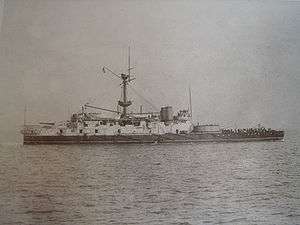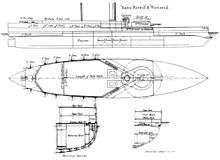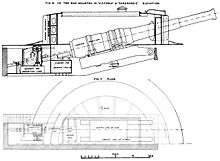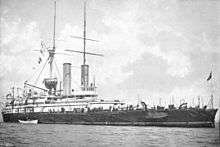Victoria-class ironclad
The Royal Navy's Victoria class (or Sans Pareil class) battleships of the 1880s was the first class which used triple expansion steam engines, previous battleships having used compound engines.
 HMS Victoria | |
| Class overview | |
|---|---|
| Preceded by: | Admiral class |
| Succeeded by: | Trafalgar class |
| In commission: | 1890-1907 |
| Completed: | 2 |
| Lost: | 1 |
| General characteristics [1] | |
| Displacement: | 11,020 tons (11,200 t) |
| Length: | 340 ft (100 m) |
| Beam: | 70 ft (21 m) |
| Draught: | 29 ft (8.8 m) |
| Propulsion: | Coal-fired triple-expansion steam engines; twin screws |
| Speed: | 16.75 knots (31.02 km/h) |
| Complement: | 630 |
| Armament: |
|
| Armour: |
|
There were only two ships in this class. The lead ship, HMS Victoria, was sunk in an accidental collision with another Royal Navy battleship in the Mediterranean with the loss of half of her crew. Her sister, HMS Sans Pareil survived until she was scrapped in April 1907.
Design

This class was intended to be an improved version of HMS Conqueror, and it was originally called the new Conquerors.
Armament

The original intention had been to fit 13.5 inch (343 mm), 67-ton guns in place of the Conqueror's 12 inch (305 mm) guns in the single forward turret but late during the design it was decided to enlarge them to take the 16.25 inch (413 mm), 110-ton gun. Similar guns had been supplied by the manufacturer, Sir W. G. Armstrong, Whitworth & Co., Ltd., to the Italian Regia Marina and fitted in the Andrea Doria and the 1,800 pound (816 kg) projectile could penetrate any thickness of armour afloat at that time. At a period when naval supremacy of the Mediterranean was seen as a crucial part of British policy, the Victoria class was intended for service as part of the British Mediterranean Fleet. The same model of gun had been fitted in the last Admiral-class battleship HMS Benbow, which had a single example in each of its two barbettes instead of pairs of 13.5 inch (343 mm) guns and was the only other British warship to carry them.
The gun was not successful in service since it took four or five minutes to load and fire. The barrel only had a 75-round life and the muzzle tended to droop.
The rear turret contained a smaller 10 inch (254 mm) gun of similar design, and which weighed 26 tons.
Seakeeping

This class was one of the last of this period to have very low freeboard, of around 10 feet (3 m). This was done to reduce target area in a naval engagement but had a deleterious effect upon seaworthiness, and was an important factor in Victoria sinking within fifteen minutes following a collision since it allowed the water to quickly reach the gun turret ports.
Propulsion
The most successful innovation of the class was the introduction of triple expansion steam engines into Royal Navy battleships. These engines had been developed as a result of the introduction of steel in boiler manufacture, which in turn had led to higher steam pressures. The Royal Navy had originally tried them with great success in the torpedo gunboat HMS Rattlesnake. The principal benefit was the improved efficiency of the engine meant a reduced displacement because less coal was needed; for example, trials with HMS Thunderer which had been re-engined with triple-expansion engines in 1889–1891[2] had shown that the coal consumption at 80% power was roughly halved.[3]
Ships
| Name | Builder | Laid down | Launched | Completed |
|---|---|---|---|---|
| Victoria | Armstrong, Mitchell & Co. | 13 June 1885 | 9 April 1887 | 1890 |
| Sans Pareil | Thames Ironworks and Shipbuilding Company | 21 April 1885 | 9 May 1887 | 1891 |
References
- Chesneau, Koleśnik & Campbell 1979, p. 30.
- Parkes, pp. 201–202.
- Brown, pp. 99–100.
Bibliography
- Chesneau, Roger; Koleśnik, Eugène M.; Campbell, N.J.M. (1979). Conway's All the World's Fighting Ships, 1860–1905. London: Conway Maritime Press. ISBN 0-85177-133-5.CS1 maint: ref=harv (link)
- David Brown, Warrior to Dreadnought: Warship development 1860–1905, Chatham Publishing.
External links
| Wikimedia Commons has media related to Victoria class battleships. |